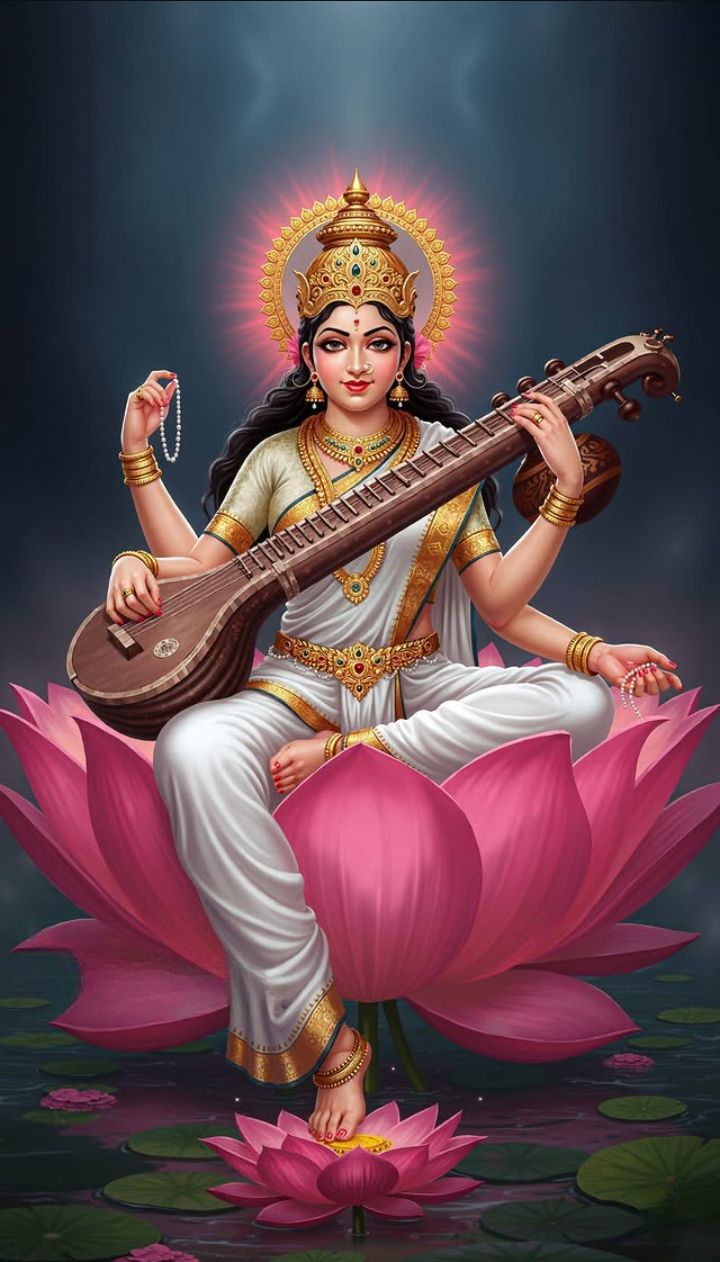9 Enlightening Facts About Goddess Saraswati That Will Boost Your Knowledge
Goddess Saraswati, revered as the goddess of knowledge, wisdom, music, and learning, holds a central place in Hindu mythology and Indian culture. She inspires students, artists, scholars, and spiritual seekers to pursue learning, creativity, and intellectual growth. Known for her serene and graceful demeanor, Saraswati embodies purity, clarity of thought, and intellectual illumination. This article explores her history, fascinating facts, timeline, significance, FAQs, daily life impact, and societal importance in a detailed, human-friendly, and inspiring manner.
Saraswati
| Characteristics : | Knowledge |
| Other Names : | Vaagdevi, Sharda |
| Consort : | Lord Brahma |
| Vehicle (Vahana) : | Swan |
| Mula Mantra : | “Om Aim Saraswatyai Namah” OR “Om Sum Saraswathaye Namah” |
| Saraswati Gayatri Mantra: | Aum Saraswatye Cha Vidmahe Brahmaputriye Cha Dheemahi Tanno Saraswati Prachodayat |
History of Goddess Saraswati
Goddess Saraswati has been revered since ancient Vedic times and her presence spans across Hindu, Jain, and Buddhist traditions:
Vedic Origins: Saraswati is first mentioned in the Rigveda, primarily as a river goddess and deity of wisdom. She was associated with purity, speech, and eloquence.
Later Puranic Texts: In texts like the Shiva Purana, Skanda Purana, and Devi Bhagavata Purana, Saraswati evolves as the goddess of learning, arts, and music, often depicted seated on a lotus, holding a veena (musical instrument).
Association with Brahma: Saraswati is considered the consort of Lord Brahma, the creator god, symbolizing that knowledge and creativity are central to creation.
Iconography: She is typically shown dressed in white, riding a swan or peacock, holding scriptures, a rosary, and the veena, signifying wisdom, purity, and artistic talent.
Medieval and Regional Worship: Saraswati’s worship became prominent in temples, monasteries, and learning centers, especially in South and North India.
Modern Era: Saraswati continues to inspire students, artists, and scholars, especially during Vasant Panchami, the festival dedicated to her.
Interesting Facts About Goddess Saraswati
Goddess of Wisdom: Saraswati embodies knowledge, learning, and intellectual clarity, guiding devotees to enlightenment.
Patron of Arts: She inspires music, poetry, painting, and all forms of creative expression.
Spiritual Significance: Saraswati represents discernment, truth, and spiritual wisdom, teaching humans to overcome ignorance.
Symbol of Purity: Her white attire and swan symbolize purity of thought, speech, and action.
Festival Celebration: Vasant Panchami, her primary festival, emphasizes education, learning, and cultural activities.
Influence Across Cultures: Saraswati is revered in Buddhism and Jainism, symbolizing knowledge and learning universally.
Iconography Significance: The books, veena, rosary, and lotus she holds represent knowledge, arts, spirituality, and purity.
Inspiration for Students: Saraswati is considered the ultimate guide for intellectual growth and academic success.
Global Influence: Her symbolism inspires learning centers, educational institutions, and cultural activities worldwide.
Timeline of Saraswati Worship
Vedic Period (c. 1500–500 BCE): Saraswati is worshiped as a river goddess and deity of wisdom.
Post-Vedic Era (c. 500 BCE–500 CE): She becomes the goddess of knowledge, arts, and music in Puranic texts.
Medieval Period (c. 8th–15th Century): Saraswati temples and rituals flourish across India; she becomes a central figure for education and arts.
Modern Era: Celebrated globally during Vasant Panchami and educational ceremonies, inspiring students and artists.
Significance of Goddess Saraswati
Goddess Saraswati holds spiritual, educational, and societal significance:
Spiritual Symbol: Represents wisdom, discernment, and intellectual illumination.
Educational Guidance: Encourages learning, creativity, and disciplined study.
Cultural Influence: Central to music, dance, literature, and fine arts, inspiring artistic expression.
Moral Guidance: Teaches truth, clarity, and ethical knowledge application.
Role Model for Students: Provides inspiration, focus, and guidance in academic and artistic pursuits.
Community and Society: Promotes educational festivals, cultural programs, and intellectual engagement.
Global Influence: Saraswati’s symbolism is incorporated in schools, colleges, and cultural centers worldwide.
FAQs About Goddess Saraswati
Q1: Who is Goddess Saraswati?
A1: Saraswati is the goddess of knowledge, wisdom, arts, and learning, guiding devotees toward intellectual and spiritual enlightenment.
Q2: What is Vasant Panchami?
A2: Vasant Panchami is the festival dedicated to Saraswati, celebrated by praying, wearing yellow, offering sweets, and initiating learning activities.
Q3: How does Saraswati influence students?
A3: She inspires academic success, creativity, discipline, and intellectual growth.
Q4: What is the symbolism behind Saraswati’s veena and swan?
A4: The veena symbolizes mastery of arts, while the swan represents purity, discernment, and wisdom.
Q5: How is Saraswati worshiped?
A5: Through temple rituals, prayers, chanting of mantras, offering flowers, and seeking blessings during educational or creative endeavors.
Impact on Daily Life
Goddess Saraswati’s influence on daily life is practical, intellectual, and cultural:
Educational Growth: Inspires students, teachers, and scholars to pursue knowledge with dedication.
Artistic Development: Encourages creativity, music, literature, and performance arts.
Spiritual Insight: Promotes discernment, clarity, and ethical application of knowledge.
Cultural Participation: Engages communities in festivals, cultural programs, and learning activities.
Personal Development: Fosters discipline, concentration, moral guidance, and intellectual curiosity.
Observance and Wishing
Vasant Panchami: Devotees worship Saraswati with prayers, flowers, books, and educational materials, seeking her blessings for learning and wisdom.
Educational Ceremonies: Many schools and universities perform Saraswati Puja to initiate new students or academic years.
Daily Devotion: Reciting her mantras, meditating on her form, and practicing arts invokes wisdom, clarity, and creative energy.
Wishing: Seek her blessings for intellectual growth, creativity, success in learning, and spiritual wisdom.
Community Participation: Festivals unite communities in cultural, educational, and devotional activities, preserving traditions.
Conclusion: Why Goddess Saraswati Matters
Goddess Saraswati is more than a deity; she symbolizes knowledge, wisdom, creativity, and purity. Her worship teaches discipline, intellectual pursuit, ethical learning, and artistic expression, impacting both personal growth and societal development.
On a societal level, Saraswati promotes education, cultural engagement, and community unity, ensuring that knowledge and creativity thrive across generations. By embracing her virtues, individuals cultivate clarity of thought, creativity, moral integrity, and spiritual insight, while society benefits from enlightened, culturally aware, and intellectually vibrant communities.
Quick Recap: 9 Enlightening Facts About Goddess Saraswati
Embodiment of wisdom, knowledge, and learning.
Patron of music, arts, and literature.
Spiritual guide teaching discernment and ethical knowledge.
Symbol of purity, clarity, and intellectual illumination.
Central to Vasant Panchami and educational rituals.
Revered in Hinduism, Jainism, and Buddhism.
Iconography symbolizes knowledge, creativity, and purity.
Inspires students, artists, and scholars worldwide.
Promotes cultural preservation, education, and community unity.








